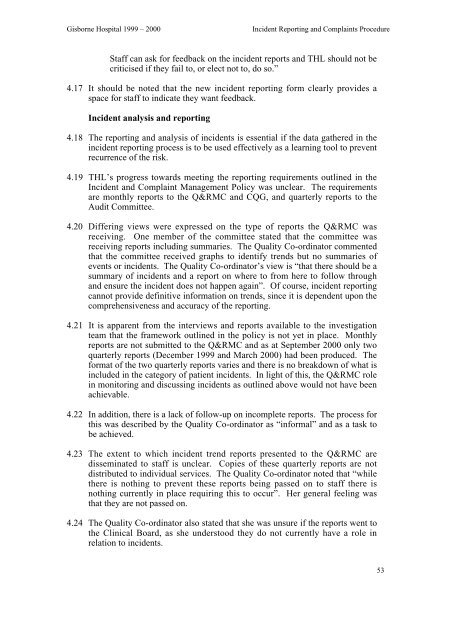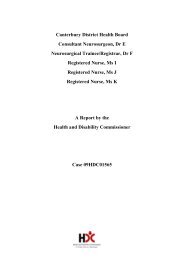Gisborne Hospital Report - Health and Disability Commissioner
Gisborne Hospital Report - Health and Disability Commissioner
Gisborne Hospital Report - Health and Disability Commissioner
Create successful ePaper yourself
Turn your PDF publications into a flip-book with our unique Google optimized e-Paper software.
<strong>Gisborne</strong> <strong>Hospital</strong> 1999 – 2000<br />
Incident <strong>Report</strong>ing <strong>and</strong> Complaints Procedure<br />
Staff can ask for feedback on the incident reports <strong>and</strong> THL should not be<br />
criticised if they fail to, or elect not to, do so.”<br />
4.17 It should be noted that the new incident reporting form clearly provides a<br />
space for staff to indicate they want feedback.<br />
Incident analysis <strong>and</strong> reporting<br />
4.18 The reporting <strong>and</strong> analysis of incidents is essential if the data gathered in the<br />
incident reporting process is to be used effectively as a learning tool to prevent<br />
recurrence of the risk.<br />
4.19 THL’s progress towards meeting the reporting requirements outlined in the<br />
Incident <strong>and</strong> Complaint Management Policy was unclear. The requirements<br />
are monthly reports to the Q&RMC <strong>and</strong> CQG, <strong>and</strong> quarterly reports to the<br />
Audit Committee.<br />
4.20 Differing views were expressed on the type of reports the Q&RMC was<br />
receiving. One member of the committee stated that the committee was<br />
receiving reports including summaries. The Quality Co-ordinator commented<br />
that the committee received graphs to identify trends but no summaries of<br />
events or incidents. The Quality Co-ordinator’s view is “that there should be a<br />
summary of incidents <strong>and</strong> a report on where to from here to follow through<br />
<strong>and</strong> ensure the incident does not happen again”. Of course, incident reporting<br />
cannot provide definitive information on trends, since it is dependent upon the<br />
comprehensiveness <strong>and</strong> accuracy of the reporting.<br />
4.21 It is apparent from the interviews <strong>and</strong> reports available to the investigation<br />
team that the framework outlined in the policy is not yet in place. Monthly<br />
reports are not submitted to the Q&RMC <strong>and</strong> as at September 2000 only two<br />
quarterly reports (December 1999 <strong>and</strong> March 2000) had been produced. The<br />
format of the two quarterly reports varies <strong>and</strong> there is no breakdown of what is<br />
included in the category of patient incidents. In light of this, the Q&RMC role<br />
in monitoring <strong>and</strong> discussing incidents as outlined above would not have been<br />
achievable.<br />
4.22 In addition, there is a lack of follow-up on incomplete reports. The process for<br />
this was described by the Quality Co-ordinator as “informal” <strong>and</strong> as a task to<br />
be achieved.<br />
4.23 The extent to which incident trend reports presented to the Q&RMC are<br />
disseminated to staff is unclear. Copies of these quarterly reports are not<br />
distributed to individual services. The Quality Co-ordinator noted that “while<br />
there is nothing to prevent these reports being passed on to staff there is<br />
nothing currently in place requiring this to occur”. Her general feeling was<br />
that they are not passed on.<br />
4.24 The Quality Co-ordinator also stated that she was unsure if the reports went to<br />
the Clinical Board, as she understood they do not currently have a role in<br />
relation to incidents.<br />
53
















